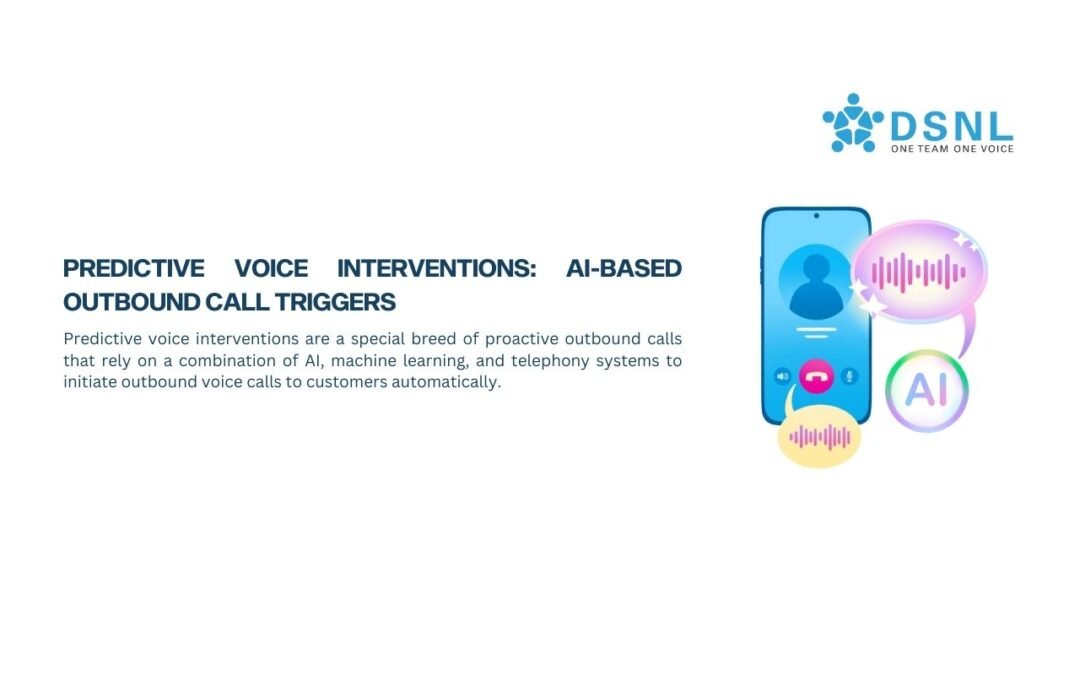Predictive voice interventions are a special breed of proactive outbound calls that rely on a combination of AI, machine learning, and telephony systems to initiate outbound voice calls to customers automatically.
AI models that analyze customer behavior, transactional history, or device signals are set up to call a user if a certain threshold is reached. For instance, the model may raise a support ticket for a customer, or add a customer to a call list that will receive an outbound voice call from a business representative.
AI at the Core of Outbound Call Triggers
AI is at the heart of predictive interventions that separate the expected from high-priority events, with systems flagging anomalies to customer experience teams for proactive outreach. Predictive algorithms analyze all kinds of structured and unstructured data available to a business in order to identify patterns in customer behavior.
Natural Language Processing (NLP) is used to power many of the outbound calls, making them highly interactive and conversational, instead of just playing robotic voice prompts.
Proactive problem resolution
Customers often have to make the effort to contact customer care first before any problems get addressed. But with predictive interventions, businesses can detect possible problems in advance and notify the customer in advance or resolve the issue before the customer realizes.
For example, a call to a customer about an upcoming service disruption or potential downtime is much better than the customer having to look it up themselves. Automated problem resolution can be achieved by using intelligence to trigger an outbound call.
Personalized engagement
AI-powered outbound calls can be personalized with previous customer data, transactional history, and preferences. A customer can be addressed by their first name, told how much is in their account, and be prompted to take actions using previously unseen call scripts, which are adapted in real-time to the predicted sentiment of the recipient.
Operational efficiency
Predictive customer interventions can be used to lower the number of inbound calls by handling many problems before they reach the support tier. Customer support costs can be cut down, freeing up agents to deal with more complex inbound calls. A reduction in inbound calls leads to a more manageable customer engagement infrastructure with predictable cost patterns.
Improved customer retention
Predictive calling engages customers at the right time, allowing businesses to demonstrate more meaningful interventions and engagement. A customer who feels “looked after” by timely interventions and notifications is less likely to leave a brand in favor of a competitor.
Real-World Use Cases
Predictive voice interventions are being used across industries in the real world, using outbound AI-based calls to provide an added value to customers:
- Banking & Finance:Fraud detection is detected by a financial monitoring AI engine, which immediately triggers an outbound call to the account holder to confirm the activity before a fraudulent transaction goes through.
- Healthcare:Automated calls are triggered to patients to remind them of medication or care schedules for post-discharge care.
- Retail & E-commerce: Updates are given about product deliveries, offers, or even abandoned shopping carts to encourage users to make a return purchase.
- Utilities:Water or power supply interruption alerts can be pushed out automatically to customers to reduce the number of incoming complaints.
- Education & Training: Exam schedule alerts, fee reminders, or course completion prompts can be automatically triggered to students through automated calls.
Future of Predictive Voice Interventions
The future of outbound voice calls driven by AI-powered predictions will only get more advanced and hyper-personalized.
A typical outbound call made over 6G in the near future will be seamlessly integrated with immersive technologies and offer more real-time audio-visual input thanks to the concurrent push of AR/VR.
NLP will get stronger, allowing calls to seamlessly understand customer requests and make interactions contextually aware. AI-driven sentiment analysis will give outbound voice calls the ability to adjust their tone and vocabulary in real-time during the call.
Conclusion
With data-driven AI automating outbound calls, enterprises can begin to move beyond a reactive customer support model to a proactive, personalized series of engagements with their customers. In the future, as we can imagine, predictive telephony will become far more than just efficiencies in scale and process, and begin to truly transform the human digital relationship, with calls driving more and more value-adding experiences.
Enterprises ready to get ahead of the game should start exploring their AI-based telephony options today. Proactive voice interventions are no longer just science fiction, but modern-day reality and the new standard for customer-centric engagement. Call our customer executive today to get further information.

